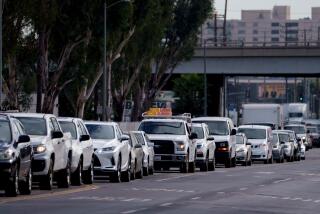These Tires Can Bounce Back After a Flat
This could be your worst freeway nightmare: You’re tooling down the 405 at night, sleepy kids in the back seat, and your trusty cell phone is nowhere in sight.
Suddenly, there’s a bang. Your car shimmies and you feel the unmistakable thump of a blown tire. Desperately, you maneuver your limping vehicle to the side of the road.
Now what? Do you get out of the car and hike with your kids to the nearest call box? Do you change it yourself? Or do you wait for the California Highway Patrol to come to your rescue?
Suffering a flat is annoying and inconvenient--the AAA received almost 3.3 million road service calls for tire problems last year. But it can be dangerous too. In fact, 18% of all pedestrian fatalities on the interstates involve people working on their cars, according to research by the AAA Foundation for Traffic Safety.
But with the introduction of new technology that seems straight out of a James Bond movie, fear of flats and freeway blowouts may become a thing of the past.
Initially fitted for luxury and touring cars, so-called run-flat tires are now available for a variety of vehicles, from minivans to Honda Accords, Ford Tauruses and Cadillac Eldorados.
With run-flat, your car could suffer a blowout or flat and you could continue driving with no air in the tire for 50 miles at speeds up to 55 mph on the freeway or for up to 200 miles in city driving.
So instead of sweating it along the side of the freeway searching for your tire iron and jack, you and your kids could still be cruising toward home. You could wait and have the tire changed or repaired the next day.
Sound comforting? That’s exactly how tire manufacturers like Goodyear and Michelin want you to feel. In a wave of new commercials for their run-flat (also called zero-pressure) tires, the companies’ marketing strategy has been to home in on motorists’ fears, touting the tires as a dramatic new safety feature.
Goodyear aired a commercial featuring a Corvette racing around a track after a hole was drilled in the sidewall of the right-front run-flat tire. And Michelin spokesman Frank Guglielmi boasts of a zero-pressure tire traveling far and fast after a golf-ball-size hole is drilled into the sidewall.
Here’s how the technology works: Michelin’s zero-pressure tires, for example, have sidewall reinforcement that allows them to continue to support the vehicle and maintain control and handling after a sudden loss of air. This reinforcement also helps to keep the tires cool, enabling them to keep traveling.
The bead (the lip-like region that seals to the rim) sports a special design aimed at keeping the tire on the wheel after total air loss, and construction design in the crown area also assists in maintaining control.
*
Although run-flats may be appealing, they don’t come cheap, and some observers even question their necessity.
Four run-flat tires, plus the warning system that is a vital component, can cost more than double the price of a quality set of traditional tires.
The tires alone run about 20% higher than regular tires, manufacturers say. The required warning system with on-wheel sensors--neither Goodyear nor Michelin will sell the tires without it--notifies the driver of a loss in air pressure. That alone can cost up to $400.
The system includes a dashboard monitor that flashes when the tire pressure is low and emits a beep when it’s dangerously low. This is critical because run-flats are so effective that drivers may not even notice they’ve had a flat and could continue to drive without repairing or inflating the tire, the manufacturers say.
As run-flats become standard on new cars, costs will drop. But at their current prices, you may be wise just to maintain and replace your traditional tires as needed.
Even at Bridgestone/Firestone, which will offer its own run-flat in August, a company executive said during a recent news conference that improving the performance of worn tires is really of more importance because it’s a daily issue for people. Flat tires aren’t as common today as they were before the addition of steel belts.
Nevertheless, struggling to change a flat tire on a busy freeway or a deserted street can leave drivers vulnerable to accidents or attacks, says Sgt. Ernie Garcia of the CHP’s Southern Division, which covers Los Angeles County.
They risk being hit by drivers who are drunk, sleepy or distracted. Or they risk encountering someone who pretends to offer help but has bad intentions, Garcia said.
The CHP hasn’t tested the run-flat tire technology, nor does it endorse products.
“But anything that will prevent you from being disabled on any street or freeway we would be in favor of,” Garcia said.
*
Highway 1 contributor Jeanne Wright cannot answer mail personally but will attempt to respond in this column to automotive questions of general interest. Do not telephone. Write to Your Wheels, 1875 I St. N.W., No. 1100, Washington, DC 20006.
Via e-mail: [email protected].






